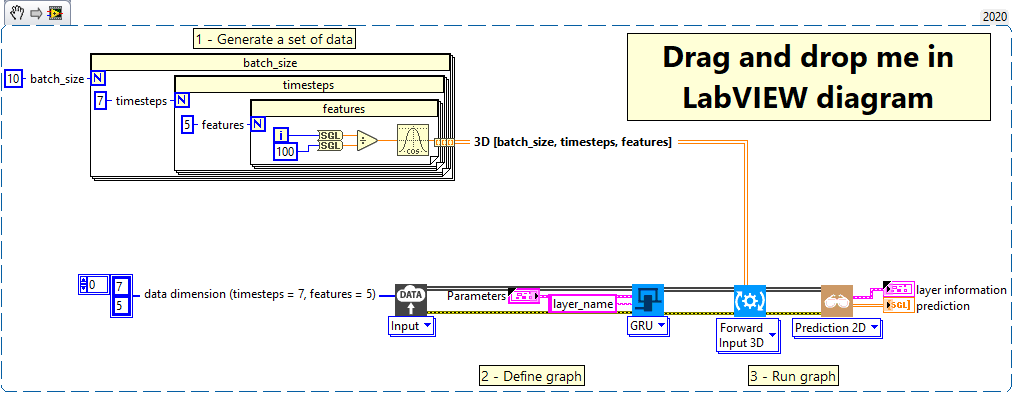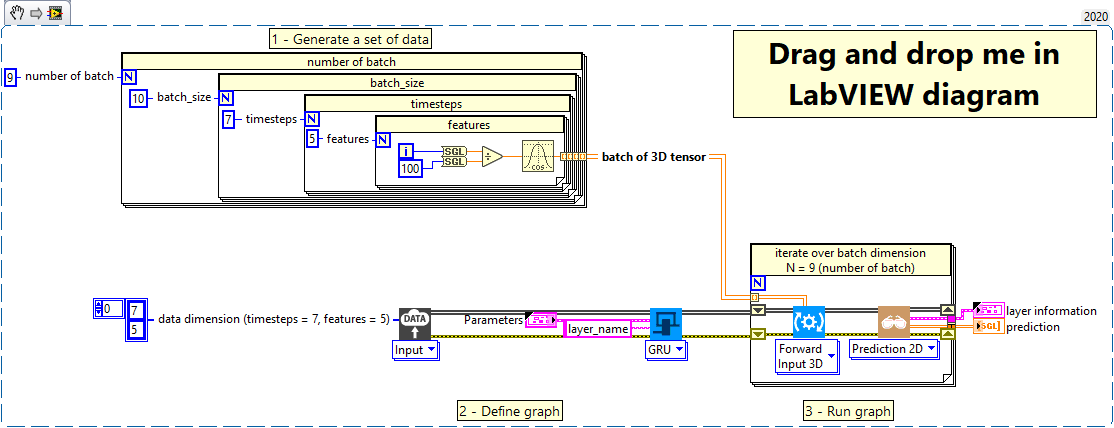-
Quick start
-
API
-
-
- Resume
- Add
- AdditiveAttention
- AlphaDropout
- Attention
- Average
- AvgPool1D
- AvgPool2D
- AvgPool3D
- BatchNormalization
- Bidirectional
- Concatenate
- Conv1D
- Conv1DTranspose
- Conv2D
- Conv2DTranspose
- Conv3D
- Conv3DTranspose
- ConvLSTM1D
- ConvLSTM2D
- ConvLSTM3D
- Cropping1D
- Cropping2D
- Cropping3D
- Dense
- DepthwiseConv2D
- Dropout
- Embedding
- Flatten
- GaussianDropout
- GaussianNoise
- GlobalAvgPool1D
- GlobalAvgPool2D
- GlobalAvgPool3D
- GlobalMaxPool1D
- GlobalMaxPool2D
- GlobalMaxPool3D
- GRU
- Input
- LayerNormalization
- LSTM
- MaxPool1D
- MaxPool2D
- MaxPool3D
- MultiHeadAttention
- Multiply
- Permute3D
- Reshape
- RNN
- SeparableConv1D
- SeparableConv2D
- SimpleRNN
- SpatialDropout
- Split
- Substract
- UpSampling1D
- UpSampling2D
- UpSampling3D
- ZeroPadding1D
- ZeroPadding2D
- ZeroPadding3D
- Show All Articles ( 46 ) Collapse Articles
-
-
-
-
-
- Resume
- Constant
- GlorotNormal
- GlorotUniform
- HeNormal
- HeUniform
- Identity
- LecunNormal
- LecunUniform
- Ones
- Orthogonal
- RandomNormal
- RandomUnifom
- TruncatedNormal
- VarianceScaling
- Zeros
- Show All Articles ( 1 ) Collapse Articles
-
-
-
-
-
-
-
- Dense
- PReLU 2D
- PReLU 3D
- PReLU 4D
- PReLU 5D
- AdditiveAttention
- Attention
- MutiHeadAttention
- Conv1D
- Conv2D
- Conv3D
- ConvLSTM1D
- ConvLSTM2D
- ConvLSTM3D
- Conv1DTranspose
- Conv2DTranspose
- Conv3DTranspose
- DepthwiseConv2D
- SeparableConv1D
- SeparableConv2D
- Embedding
- BatchNormalization
- LayerNormalization
- Bidirectional
- GRU
- LSTM
- SimpleRNN
- Show All Articles ( 12 ) Collapse Articles
-
- Dense
- PReLU 2D
- PReLU 3D
- PReLU 4D
- PReLU 5D
- AdditiveAttention
- Attention
- MultiHeadAttention
- Conv1D
- Conv2D
- Conv3D
- ConvLSTM1D
- ConvLSTM2D
- ConvLSTM3D
- Conv1DTranspose
- Conv2DTranspose
- Conv3DTranspose
- DepthwiseConv2D
- SeparableConv1D
- SeparableConv2D
- Embedding
- BatchNormalization
- LayerNormalization
- Bidirectional
- GRU
- LSTM
- SimpleRNN
- Show All Articles ( 12 ) Collapse Articles
-
-
- Dense
- AdditiveAttention
- Attention
- MultiHeadAttention
- BatchNormalization
- LayerNormalization
- Bidirectional
- GRU
- LSTM
- SimpleRNN
- Conv1D
- Conv2D
- Conv3D
- Conv1DTranspose
- Conv2DTranspose
- Conv3DTranspose
- ConvLSTM1D
- ConvLSTM2D
- ConvLSTM3D
- DepthwiseConv2D
- SeparableConv1D
- SeparableConv2D
- Embedding
- PReLU 2D
- PReLU 3D
- PReLU 4D
- PReLU 5D
- Show All Articles ( 12 ) Collapse Articles
-
-
- Dense
- Embedding
- AdditiveAttention
- Attention
- MultiHeadAttention
- Conv1D
- Conv2D
- Conv3D
- ConvLSTM1D
- ConvLSTM2D
- ConvLSTM3D
- Conv1DTranspose
- Conv2DTranspose
- Conv3DTranspose
- DepthwiseConv2D
- SeparableConv1D
- SeparableConv2D
- BatchNormalization
- LayerNormalization
- PReLU 2D
- PReLU 3D
- PReLU 4D
- PReLU 5D
- Bidirectional
- GRU
- LSTM
- RNN (GRU)
- RNN (LSTM)
- RNN (SimpleRNN)
- SimpleRNN
- Show All Articles ( 15 ) Collapse Articles
-
- Dense
- Embedding
- AdditiveAttention
- Attention
- MultiHeadAttention
- Conv1D
- Conv2D
- Conv3D
- ConvLSTM1D
- ConvLSTM2D
- ConvLSTM3D
- Conv1DTranspose
- Conv2DTranspose
- Conv3DTranspose
- DepthwiseConv2D
- SeparableConv1D
- SeparableConv2D
- BatchNormalization
- LayerNormalization
- PReLU 2D
- PReLU 3D
- PReLU 4D
- PReLU 5D
- Bidirectional
- GRU
- LSTM
- RNN (GRU)
- RNN (LSTM)
- RNN (SimpleRNN)
- SimpleRNN
- Show All Articles ( 15 ) Collapse Articles
-
-
-
- Dense
- Embedding
- AdditiveAttention
- Attention
- MultiHeadAttention
- Conv1D
- Conv2D
- Conv3D
- ConvLSTM1D
- ConvLSTM2D
- ConvLSTM3D
- Conv1DTranspose
- Conv2DTranspose
- Conv3DTranspose
- DepthwiseConv2D
- SeparableConv1D
- SeparableConv2D
- BatchNormalization
- LayerNormalization
- PReLU 2D
- PReLU 3D
- PReLU 4D
- PReLU 5D
- Bidirectional
- GRU
- LSTM
- RNN (GRU)
- RNN (LSTM)
- RNN (SimpleRNN)
- SimpleRNN
- Show All Articles ( 15 ) Collapse Articles
-
- Dense
- Embedding
- AdditiveAttention
- Attention
- MultiHeadAttention
- Conv1D
- Conv2D
- Conv3D
- ConvLSTM1D
- ConvLSTM2D
- ConvLSTM3D
- Conv1DTranspose
- Conv2DTranspose
- Conv3DTranspose
- DepthwiseConv2D
- SeparableConv1D
- SeparableConv2D
- BatchNormalization
- LayerNormalization
- PReLU 2D
- PReLU 3D
- PReLU 4D
- PReLU 5D
- Bidirectional
- GRU
- LSTM
- RNN (GRU)
- RNN (LSTM)
- RNN (SimpleRNN)
- SimpleRNN
- Show All Articles ( 15 ) Collapse Articles
-
-
-
- Resume
- Accuracy
- BinaryAccuracy
- BinaryCrossentropy
- BinaryIoU
- CategoricalAccuracy
- CategoricalCrossentropy
- CategoricalHinge
- CosineSimilarity
- FalseNegatives
- FalsePositives
- Hinge
- Huber
- IoU
- KLDivergence
- LogCoshError
- Mean
- MeanAbsoluteError
- MeanAbsolutePercentageError
- MeanIoU
- MeanRelativeError
- MeanSquaredError
- MeanSquaredLogarithmicError
- MeanTensor
- OneHotIoU
- OneHotMeanIoU
- Poisson
- Precision
- PrecisionAtRecall
- Recall
- RecallAtPrecision
- RootMeanSquaredError
- SensitivityAtSpecificity
- SparseCategoricalAccuracy
- SparseCategoricalCrossentropy
- SparseTopKCategoricalAccuracy
- Specificity
- SpecificityAtSensitivity
- SquaredHinge
- Sum
- TopKCategoricalAccuracy
- TrueNegatives
- TruePositives
- Show All Articles ( 28 ) Collapse Articles
-
-
GRU
Description
Setup and add the gru layer into the model during the definition graph step. Type : polymorphic.

Input parameters
![]() Model in : model architecture.
Model in : model architecture.
![]() Parameters : layer parameters.
Parameters : layer parameters.
![]() units : integer, dimensionality of the output space.
units : integer, dimensionality of the output space.![]() Activation : cluster, activation function to use.
Activation : cluster, activation function to use.![]() Recurrent Activation : cluster, activation function to use for the recurrent step.
Recurrent Activation : cluster, activation function to use for the recurrent step.![]() use bias? : boolean, whether the layer uses a bias vector.
use bias? : boolean, whether the layer uses a bias vector.
Default value “True”.![]() Input Weight Initializer : cluster, initializer for the
Input Weight Initializer : cluster, initializer for the kernel weights matrix, used for the linear transformation of the inputs.![]() Hidden Weight Initializer : cluster, initializer for the
Hidden Weight Initializer : cluster, initializer for the recurrent_kernel weights matrix, used for the linear transformation of the recurrent state.![]() Bias Initializer : cluster, initializer for the bias vector.
Bias Initializer : cluster, initializer for the bias vector.![]() dropout : float, fraction of the units to drop for the linear transformation of the inputs.
dropout : float, fraction of the units to drop for the linear transformation of the inputs.
Default value “0.0”.![]() recurrent dropout : float, fraction of the units to drop for the linear transformation of the recurrent state.
recurrent dropout : float, fraction of the units to drop for the linear transformation of the recurrent state.
Default value “0.0”.![]() return sequences? : boolean, whether to return the last output in the output sequence, or the full sequence.
return sequences? : boolean, whether to return the last output in the output sequence, or the full sequence.
Default value “False”.![]() stateful? : boolean, if True, the last state for each sample at index i in a batch will be used as initial state for the sample of index i in the following batch.
stateful? : boolean, if True, the last state for each sample at index i in a batch will be used as initial state for the sample of index i in the following batch.
Default value “False”.![]() Input Weight Regularizer : cluster, regularizer function applied to the
Input Weight Regularizer : cluster, regularizer function applied to the kernel weights matrix.![]() Hidden Weight Regularizer : cluster, regularizer function applied to the
Hidden Weight Regularizer : cluster, regularizer function applied to the recurrent_kernel weights matrix.![]() Bias Regularizer : cluster, regularizer function applied to the bias vector.
Bias Regularizer : cluster, regularizer function applied to the bias vector.![]() training? : boolean, whether the layer is in training mode (can store data for backward).
training? : boolean, whether the layer is in training mode (can store data for backward).
Default value “True”.![]() store? : boolean, whether the layer stores the last iteration gradient (accessible via the “get_gradients” function).
store? : boolean, whether the layer stores the last iteration gradient (accessible via the “get_gradients” function).
Default value “False”.![]() update? : boolean, whether the layer’s variables should be updated during backward. Equivalent to freeze the layer.
update? : boolean, whether the layer’s variables should be updated during backward. Equivalent to freeze the layer.
Default value “True”.![]() lda coeff : float, defines the coefficient by which the loss derivative will be multiplied before being sent to the previous layer (since during the backward run we go backwards).
lda coeff : float, defines the coefficient by which the loss derivative will be multiplied before being sent to the previous layer (since during the backward run we go backwards).
Default value “1”.
![]() name (optional) : string, name of the layer.
name (optional) : string, name of the layer.
Output parameters
![]() Model out : model architecture.
Model out : model architecture.
Dimension
Input shape
A 3D tensor, with shape : (batch, timesteps, features).
Output shape
3D tensor with shape :
- If “return_sequences” = True : (batch_size, timesteps, units).
- If “return_sequences” = False : (batch_size, units).
Example
All these exemples are snippets PNG, you can drop these Snippet onto the block diagram and get the depicted code added to your VI (Do not forget to install Deep Learning library to run it).
GRU layer

1 – Generate a set of data
We generate an array of data of type single and shape [batch_size = 10, timesteps = 7, features = 5].
2 – Define graph
First, we define the first layer of the graph which is an Input layer (explicit input layer method). This layer is setup as an input array shaped [timesteps = 7, features = 5].
Then we add to the graph the GRU layer.
3 – Run graph
We call the forward method and retrieve the result with the “Prediction 2D” method.
This method returns two variables, the first one is the layer information (cluster composed of the layer name, the graph index and the shape of the output layer) and the second one is the prediction with a shape of [batch_size, units].
The output dimension depends on the parameters “return-sequences” refer to the chapter “Dimension” of this documentation.
GRU layer, batch and dimension

1 – Generate a set of data
We generate an array of data of type single and shape [number of batch = 9, batch_size = 10, timesteps = 7, features = 5].
2 – Define graph
First, we define the first layer of the graph which is an Input layer (explicit input layer method). This layer is setup as an input array shaped [timesteps = 7, features = 5].
Then we add to the graph the GRU layer.
3 – Run graph
We call the forward method and retrieve the result with the “Prediction 2D” method.
This method returns two variables, the first one is the layer information (cluster composed of the layer name, the graph index and the shape of the output layer) and the second one is the prediction with a shape of [batch_size, units].
The output dimension depends on the parameters “return-sequences” refer to the chapter “Dimension” of this documentation.


